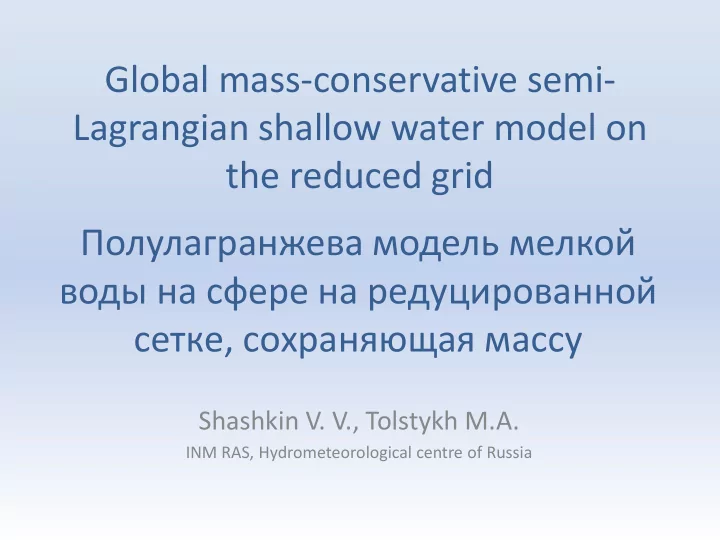

Global mass-conservative semi- Lagrangian shallow water model on the reduced grid Полулагранжева модель мелкой воды на сфере на редуцированной сетке, сохраняющая массу Shashkin V. V., Tolstykh M.A. INM RAS, Hydrometeorological centre of Russia
Motivation SL-AV (ПЛАВ) Model (Tolstykh 2010): • Main Russian global operational model for medium-range and seasonal forecasts • Global finite-difference semi-Lagrangian semi-implicit dynamical core • Scales up to 100-300 cores, MPI+OpenMP Motivation for further development of dynamical core: • Regular lat-lon grid => Highest resolution 20-30 km • No mass-conservation (tracer and atmosphere) => ex. Spurious sources and sinks of humidity, wrong model precipitations • Hydrostatic equations => Highest resolution about 10km
New version of the dynamical core Desired features of new version: • Resolution of 5-10 km • Quasi-monotonic (reduced) grid (fig. 1) • Non-hydrostatic • Mass-conservation (tracer and atmosphere) • More scalability Mass conservation and reduced grid are implemented in the shallow water version Figure 1. Reduced lat-lon grid
Global Mass-Conservative Shallow water model on the reduced grid (SL-AV-2D) • Shallow water equations on the sphere: - depth of the fluid multiplied by g d v 2 r - horizontal wind velocity v dt D divv d D - radius vector of a point r dt Mass conservation 2 d 2 d d cos 0 dt 0 2 Locally conservative SL advection Conservative Helmholtz problem algorithm (Conservative Cascade solver (<= semi-implicite time integration) – finite volume, 2 nd Scheme, Nair, 2002), version for reduced grid order of accuracy • Version with using of Conservative Cascade Scheme for discretization of absolute vorticity equation
Numerical tests • Global steady state geostrophic flow ( №2 – Williamson et al. 1992) • Zonal flow over an isolated mountain ( № 5 – Williamson et al. 1992) • Rossby-Haurwitz wave propagation ( № 6 – Williamson et al. 1992) • Quasi real-data ( № 7a-c – Williamson et al. 1992) • Barotropic instability (Galewsky et al. 2004) Regular and reduced (Fadeev, 2006) grids of various resolutions Figure 2. Quasi real- data test (case “c”). Left panel – numerical solution of high resolution (T213) spectral model (day 5), right panel – numerical solution of the mass-conservative semi-Lagrangian model (day 5), resolution – 1,5 0 x 1,5 0
Conclusions Summary of numerical results: • L2 normalized errors (depth field) of the numerical solutions of mass- conservative and basic non-conservative models are practically indistinguishable • The impact of the reduced grid in the most complicated tests is negligible • Using of conservative cascade scheme for discretization of absolute vorticity equation improves accuracy of the model only in “quasi real - data” test cases №7a -c, Williamson et al. 1992 Future plans: • We are working now on the implementation of 3D locally-conservative semi-Lagrangian advection scheme • The implementation of mass-conservative version of global semi- Lagrangian SL-AV (Tolstykh, 2010) model is planned
Thank you for your attention! • See “Global mass -conervative semi-Lagrangian shallow water model on the reduced grid” poster (V.V. Shashkin, M.A. Tolstykh) poster for more details The work was supported by RFBR grant 10-05-01066 and RAS basic research program №14
Recommend
More recommend